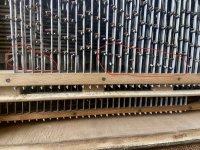Me too, I’m compulsive greaser. That’s a good thing around farm and construction equipment, even french horn and trumpet. Use a lot of dry lube too.
I have no experience with any kind of lube on accordions but I read warnings, e.g. From George Bachich on the Accordion Revival web site:
NEVER OIL YOUR ACCORDION
Accordions are big air filters. Lots of air is pumped through them, and the moisture, dust and lint in the air all tend to collect on interior parts, so the air emerges cleaner than it went in. This accumulation of lint in the accordion is inevitable, but oiling any part in the accordion tends to make it even worse. The oil attracts more dust and lint than before, and when enough of it combines with the oil, it makes a thick, gooey substance that can cause keys, bass buttons, and register switches and slides to stick.
When you encounter a sticking key, button, switch, or slide, you may be tempted to oil it, but on accordions you should resist that temptation. The better course is to take it apart, clean it thoroughly, determine the source of friction, sand, smooth, polish, realign, or loosen parts as necessary to reduce the friction, and put it back together dry. Although oil may seem to help in the short run, in the long run you will regret using it. If you absolutely must use some lubricant, try graphite, but very sparingly, or you will have another kind of mess as the graphite spreads to areas you never intended it to go.
My own experience with lubricating instruments made from wood/leather/cloth/metal is with pianos, for example when rebuilding and maintaining a player piano - powdered graphite is recommended, and as George mentions, used sparingly, very sparingly. I put a tiny smear on a finger or piece of leather or felt and rub it on sliding/rotating surfaces. The graphite I used came in a small cardboard tube with a felt applicator. Also, one of the absolute Dos and Don'ts for player pianos is never use oil on the rotating parts/joints but instead use bearing grease or vaseline (again, sparingly). I wonder if this is appropriate for accordions too.



